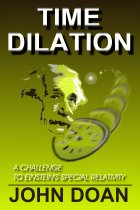"A major fallacy unique in scientific history." Have you ever read the book Has Hawking Erred written by Gerhard Kraus in 1993 with that daring statement about Einstein's time dilation?
"The fact that nearly all academic physicists support Special Relativity proves nothing about its validity," said by John Chappell Jr., chairman of NPA, in 1996. Did you know that 90 years after Einstein's Relativity publication, physicists still fail to stop their own colleagues' criticism against the theory?
"All motions may be accelerated and retarded, but the flowing of absolute time is liable to no change," said Isaac Newton. Did you know that all so-called evidence thought to confirm Einstein's time dilation, in fact only confirm Newton's law that motion can be changed, but time is still absolute?
- Have you ever wondered what time is?
- What is time dilation?
- What is space curvature?
- Why can our space be curved?
- Did you ever feel sick of hearing physicists admit how confused they are about time, yet they can be so sure of time dilation?
- Did you ever feel convinced listening to physicists describe what 4-dimensional space-time is like, while saying you cannot draw it?
- Did you ever feel stupid for not understanding Einstein and Relativity but still happily accepting it?
- Did you ever dare think Einstein is wrong, but not dare say it due to your limited Math and Physics?
- Whatever your favourite excuse, do you ever believe one day you CAN understand Einstein and realize he is wrong?
- If you never bother asking those questions, don't read this book for this book is nothing but a challenge to Einstein's Relativity!
"This book, in 10 Chapters and 191 pages, describes the "tour de force" of a common sensed person, with average scientific education but not a physicist himself, in search for an understanding of Einstein's Relativity theory. He is convinced that at least three important points of the theory are total flaws: 1-time dilation; 2-space curvature; and 3-the absolute constancy of light speed, regardless of source velocity or observer velocity. The first two chapters set the dialectical stage, quote some dissidents of RT (Relativity Theory) including my own group (Natural Philosophy Alliance) and Gerhard Kraus, and anticipates some of the author's theses, but without much reasoning. In fact these two initial chapters appear to me somehow vague and slow. It is in Chap. 3 (an imaginary interview with Einstein) where we start reading some solid arguments, mostly describing the disconcerting variety of opinions that 20 relativistic authors explored by John Doan hold respect Time Dilation. On page 35 John Doan presents the critique. It is not original but is forcefully expressed and repeated along the entire book as a leitmotiv, namely, that asymmetric time aging as usually claimed by a group of relativists when one clock moves back and forth, showing "less" time than an identical clock that remained at "rest" at the origin, is a logical impossibility . Since relative motion is perfectly reciprocal, symmetric and interchangeable, there is no way to say which clock must really go slower. They can both get slower, leading to a>b and a<b simultaneously.
"The arguments against space-curvature and light speed constancy are less forcefully presented. John Doan even dares to give his own version of 4-D space which I personally cannot approve (it is still 3-D). Concerning light speed he describes the relativistic position as claiming that c+v = c, or that c+c = c. These, of course, are inaccurate expressions which relativists do not endorse. But the reader gets the hint that in practice this is what RT concludes using its velocity composition expression, (which the author does not quote). After an imaginary interview with Einstein and asking him twenty questions that he cannot answer the author is ready to "divorce" Relativity and return to Newtonian absolute space and time.
"In an equally imaginary interview with Newton Time Dilation is replaced by "motion change". John Doan does not question the possibility of Time Dilation provided it is due to an asymmetric physical cause, not to Einstein's uniform motion only, and provided we refer it to a physical change in a clock, not in "Time", whatever Time means. Newton's affirmations sound a bit authoritarian but his absolute space, time and simultaneity win the day in the author's view.
"The next Chapter, (7), is a grand detour into the "relativity of language" which, to this reviewer, seems the weakest portion of the book, and not too much needed at all, though it contains a high dose of human insights and situations. The following two Chapters present the final attack on Time Dilation and the replacement of Einstein by Newton. Topics like asymmetry vs. symmetry, relative vs absolute, are discussed. The author uses the method of analogical comparisons to guide the reader through the intricacies of relativistic thought. In the final chapter an unexpected biographical experience, concerning a friend killed at war who was a relativistic dissident since adolescence, moves the reader almost to compassion. The plea for understanding rises here to its climax, but only to conclude that no matter what is done, Relativity will always "win". In an Epilogue the author asks Stephen Hawking, whom he praises, to become a new Einstein, but against Einstein." - Francisco M?ller



